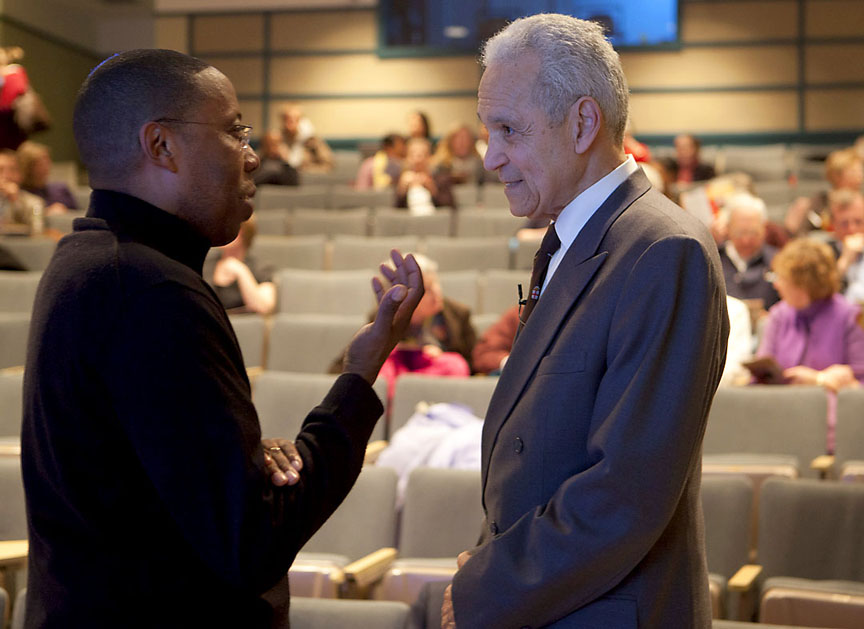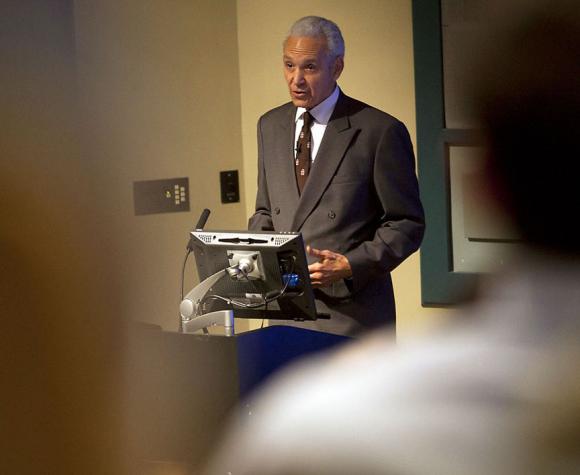Eminent Harvard orthopaedic surgeon and Brown alumnus Augustus White III brought a simple message to a lecture and book-signing sponsored by the Warren Alpert Medical School March 2: Physician, know thyself — otherwise doctors’ largely subconscious discrimination against a wide variety of patients will continue.
“If you stop any doctor on the street and say, ‘Doctor, are you aware of all the racism and all of the disparities in health care?’ He or she will say, ‘I don’t know what you are talking about. I take good care of all my patients,’” White told the audience in the Salomon Center. “The data will suggest that there is some subconscious disparity being practiced.”
White, author of the new book Seeing Patients: Unconscious Bias in Health Care, identified 13 groups of patients that experience health care discrimination and disparities, including not only racial and religious minorities and immigrants but also women, the obese, the elderly, the disabled, and the imprisoned.
White, who graduated from Brown in 1957 as one of only four blacks in his class, said studies show that women aren’t rushed to the emergency room as quickly as men when they experience heart attacks, and they get less medication afterward. Blacks are less likely to get kidney or liver transplants. Hispanics, he said, have a 50-percent lower chance than whites of getting narcotic pain medication after a bone fracture.

Doctors, of course, aren’t the sole source of health disparities in the country. White also noted that racism exists not only at an institutional level but also in the lowered expectations that members of disadvantaged groups carry.
“A lot of studies suggest that African Americans don’t ask as many questions or ask for as many kinds of treatment,” he said. “The implication is that they’ve internalized racism and feel less worthy than others might.”
The disparities in preventive care that come from racism and other forms of discrimination, White said, have a tremendous economic cost. He cited a report by the Joint Center for Political and Economic Studies, saying that between 2003 and 2006 disparities affecting minorities added $229 billion to health care spending.
The solution of self-awareness
White, who has spoken out about health disparities for years, said he’s seen more than 100 proposed solutions to the problem, including increasing the diversity of the caregiving workforce and elevating the priority given to culturally competent care in medical education. In addition to teaching orthopaedic surgery at Harvard Medical School, White is also a professor of medical education there.
He particularly praised an educational directive of the medical school accreditation organization sponsored by both the American Medical Association and the American Association of Medical Colleges. Directive 22 states, “Medical students must learn to recognize and appropriately address gender and cultural biases in themselves and others, and in the process of health care delivery.”
In his suggestions for how doctors can reduce their subconscious contribution to health disparities, White focused on that theme of self-awareness.
“For caregivers, first of all believe that biases exist,” he said. “It is easy to blow it off and say that it’s not really a problem. And believe that they can be corrected.”
He offered the website of Harvard psychology colleague Mahzarin Banaji as a tool for personally exploring subconscious bias: implicit.harvard.edu.
White also advised patients to increase their health literacy and knowledge of their conditions and to be polite but frank with their doctors about bias if they feel they are experiencing it.
At that personal scale or at the scale of national policy, White said the recently passed health care law will help by improving health care access and by elevating a center for research on disparity to an institute level at the National Institutes of Health. But the problem of health disparities remains “difficult and formidable,” White said.
“We must improve it,” he said. “It’s unethical, it’s inhumane.”

